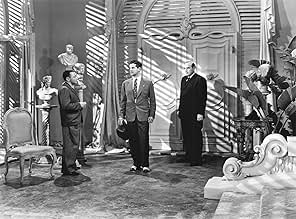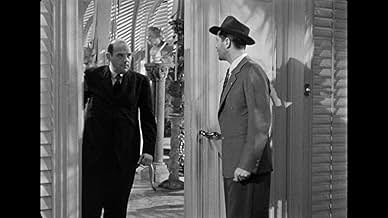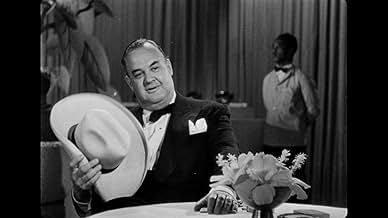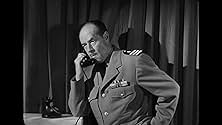AVALIAÇÃO DA IMDb
6,4/10
2,9 mil
SUA AVALIAÇÃO
Adicionar um enredo no seu idiomaChuck Scott gets a job as chauffeur to tough guy Eddie Roman; but Chuck's involvement with Eddie's fearful wife becomes a nightmare.Chuck Scott gets a job as chauffeur to tough guy Eddie Roman; but Chuck's involvement with Eddie's fearful wife becomes a nightmare.Chuck Scott gets a job as chauffeur to tough guy Eddie Roman; but Chuck's involvement with Eddie's fearful wife becomes a nightmare.
- Direção
- Roteiristas
- Artistas
- Prêmios
- 1 indicação no total
Michèle Morgan
- Lorna Roman
- (as Michele Morgan)
Nina Koshetz
- Madame Chin
- (as Nina Koschetz)
Florence Auer
- Miss Connors
- (não creditado)
Spencer Chan
- Customer Patron
- (não creditado)
Herbert Evans
- Havana Cafe Customer
- (não creditado)
Tom Ferrandini
- Nightclub Patron
- (não creditado)
Bess Flowers
- Nightclub Patron
- (não creditado)
- Direção
- Roteiristas
- Elenco e equipe completos
- Produção, bilheteria e muito mais no IMDbPro
Avaliações em destaque
A troubled ex-serviceman gets a job with a crime boss and his disturbed wife.
A 'find' for me and perhaps for other fans of noir. The 80-minutes are a perfect blend of dark visuals and surreal story. Frankly, when I think noir, I don't think Bob Cummings, an excellent light comedy actor, but hardly a figure of depth. But here, he essays the role of the troubled vet in subtle and persuasive ways. The nightclub scenes in Havana are particularly revealing, as the chaotic gaiety swirls around Scott (Cummings) and his spacey lover Lorna (Morgan)—a perfect metaphor for their circumstance.
A number of touches make this a memorable film. Casting Lorre as Gino was a coup, since his quietly devilish imp casts a background shadow over the proceedings. That's significant because Cochran, the alleged crime boss, comes across as a rather charming fellow even if he's behind dark deeds. Then there's that scene in the wine cellar, unlike any I've seen, and shrewdly abbreviated to catch the imagination. Also, catch Lorna's cameo framing through the porthole with shadows rising and falling over her face, as her nature itself migrates between light and dark. Add to the mix a speeding locomotive as the hand of fate, and a weirdly backseat driver that really is a backseat driver, and you've got an appropriately noirish race against time. And, of course, mustn't leave out the final scene so perfectly calibrated to end the film on a provocatively surreal note.
The movie's full of such imaginative twists and turns as penned by two of the best in the business, Woolrich and Yordan. I'm not sure why the movie's generally overlooked in the noir canon, perhaps because of Bob Cummings and his lightweight reputation, plus the lack of a true spider woman. Nonetheless, it's a provocative little gem, and one that prompts rare second thoughts long after the screen has gone dark.
A 'find' for me and perhaps for other fans of noir. The 80-minutes are a perfect blend of dark visuals and surreal story. Frankly, when I think noir, I don't think Bob Cummings, an excellent light comedy actor, but hardly a figure of depth. But here, he essays the role of the troubled vet in subtle and persuasive ways. The nightclub scenes in Havana are particularly revealing, as the chaotic gaiety swirls around Scott (Cummings) and his spacey lover Lorna (Morgan)—a perfect metaphor for their circumstance.
A number of touches make this a memorable film. Casting Lorre as Gino was a coup, since his quietly devilish imp casts a background shadow over the proceedings. That's significant because Cochran, the alleged crime boss, comes across as a rather charming fellow even if he's behind dark deeds. Then there's that scene in the wine cellar, unlike any I've seen, and shrewdly abbreviated to catch the imagination. Also, catch Lorna's cameo framing through the porthole with shadows rising and falling over her face, as her nature itself migrates between light and dark. Add to the mix a speeding locomotive as the hand of fate, and a weirdly backseat driver that really is a backseat driver, and you've got an appropriately noirish race against time. And, of course, mustn't leave out the final scene so perfectly calibrated to end the film on a provocatively surreal note.
The movie's full of such imaginative twists and turns as penned by two of the best in the business, Woolrich and Yordan. I'm not sure why the movie's generally overlooked in the noir canon, perhaps because of Bob Cummings and his lightweight reputation, plus the lack of a true spider woman. Nonetheless, it's a provocative little gem, and one that prompts rare second thoughts long after the screen has gone dark.
In just the first scene the noir schmuck, an ex-GI back from the war, is wistfully looking at a man frying bacon behind a shopwindow, looks down, where —lo— in a sardonic twist of noir fate, he discovers a wallet full of money. Being a straight-up guy, he shows up at the mobster's place in Miami to return it, where he's promptly hired as a driver, falls for the unhappy wife, and elopes with her to Havana, the place of desire.
It's a dreamy setup worthy of the most profound noir, but the movie outright fails — the acting is stiff, the romance is forced, the pace is lethargic, the camera is uninteresting. We simply have second- grade talent doing poverty row work for a quick pay.
But even botched Woolrich is something, and this one's just so bizarre.
The narrator, our GI schmuck, suffers such intense anxiety (possibly related to the war, as often in noir). Midway through the narration breaks down and re-arranges the world. This is preceded by his very own death following a very murky chase through Havana, another deeply noirish twist. Anyway, it turns out that he was never in Havana, though he has the two tickets in his pocket.
We have obvious hallucination but the weirdest thing is as follows: 'when' the hallucination starts is undefinable and the ensuing 'real' story picks up from some point in it and culminates in another previously hallucinated moment in Havana. It's strange, because nothing is really done with it. But as clear explication of noir—as with Woolrich's Fear in the Night, almost too clear for my taste—this is straight to the point.
Noir Meter: 3/4
It's a dreamy setup worthy of the most profound noir, but the movie outright fails — the acting is stiff, the romance is forced, the pace is lethargic, the camera is uninteresting. We simply have second- grade talent doing poverty row work for a quick pay.
But even botched Woolrich is something, and this one's just so bizarre.
The narrator, our GI schmuck, suffers such intense anxiety (possibly related to the war, as often in noir). Midway through the narration breaks down and re-arranges the world. This is preceded by his very own death following a very murky chase through Havana, another deeply noirish twist. Anyway, it turns out that he was never in Havana, though he has the two tickets in his pocket.
We have obvious hallucination but the weirdest thing is as follows: 'when' the hallucination starts is undefinable and the ensuing 'real' story picks up from some point in it and culminates in another previously hallucinated moment in Havana. It's strange, because nothing is really done with it. But as clear explication of noir—as with Woolrich's Fear in the Night, almost too clear for my taste—this is straight to the point.
Noir Meter: 3/4
This is an exciting film noir with good performances & a tough script by Woolrich (anytime you see his name associated with a movie, it's a sign of quality, even for low budget series like Robert Dix's "The Whistler"). Robert Cummings gives one of the best performances of his life, because he avoids all those "Love That Bob" clichés he used to do so well (but sometimes, so inappropriately). Steve Cochran is very menacing & very sick as a sadistic mobster who wants to control everyone & everything around him (wait til you see his car, it's really neat!). Peter Lorre is prime Lorre, in a menacing role as Cochran's henchman. Michele Morgan is suitable as Cochran's sultry wife. The plot is not new, we've seen it before (& after), about an unhappily married wife who uses a friend to escape her husband. But the story's done in an interesting way, with some unusual aspects to it. There's plenty of shadows & lots of the movie takes place at night. The Chase moves at fast pace for the first 50 minutes or so, then slows down to catch it's breath, & then speeds up again near the end. I rate it 8/10.
This is one of the most off-beat noirs you will ever see.It ranges from tension to turmoil in short bursts because it is, ah, different.You may have to run parts of it back to see if you missed something - but chances are you didn't. It's that kind of film.
The heavies are the best part of the cast. Steve Cochran may have done his best work here, and Peter Lorre does what he does best.Michele Morgan is lovely, and Bob Cummings seems as confused as the rest of us. I enjoy plot twists to a point, but the whole picture is a plot twist.
You may have to struggle with the continuity and the sound track, as the film was assembled piecemeal and the restoration is not as good as could be hoped. Against my better judgment I gave this a 7, although on balance it's not that good; it's just so - how should we say - bizarre.
The heavies are the best part of the cast. Steve Cochran may have done his best work here, and Peter Lorre does what he does best.Michele Morgan is lovely, and Bob Cummings seems as confused as the rest of us. I enjoy plot twists to a point, but the whole picture is a plot twist.
You may have to struggle with the continuity and the sound track, as the film was assembled piecemeal and the restoration is not as good as could be hoped. Against my better judgment I gave this a 7, although on balance it's not that good; it's just so - how should we say - bizarre.
The Chase is directed by Arthur Ripley and adapted to screenplay by Philip Yordan from the novel The Black Path of Fear written by Cornell Woolrich. It stars Robert Cummings, Steve Cochran, Michèle Morgan, Peter Lorre and Jack Holt. Music is by Michel Michelet and cinematography comes from Frank F. Planer. Plot finds Cummings as World War II veteran Chuck Scott, drifting and skint, he finds a wallet and returns it to the owner. The owner is one Eddie Roman (Cochran), an apparently wealthy and thriving business man who repays Chuck's honesty by giving him a job as a chauffeur. Nothing from here on in will ever be the same....
The Chase is one of those films that fell in to the public domain, got a cult following in spite of the number of bad prints out there, and now arguably deserves a place on the must see list of film noir enthusiasts. Bad prints aside, The Chase deals in oppressive atmosphere and lives in the void caught between a dream and a nightmare. Ripley (Thunder Road 1958) crafts his whole film in a dream state, keeping it mostly nocturnal, he and photographer Franz Planer thrive on Woolrich's premise and use slow pacing and shadow play to smoother the characters. It feels stifling, odd even, but with a couple of tricks up his sleeve, Ripley garners maximum impact by disorientating the viewer for the wonderfully absurd ending. Some may call out cheat, others are likely to enjoy its Wellesian feel, either way it's certainly a film that can't be called dull.
Cummings is fine as the good guy suddenly finding his world shifting sideways in a blur of pills, sleep and perfume, while Morgan registers nicely - even if ultimately she's underused and often her character is just there to make a romantic point. Cochran, in only his second year of acting, is a dominating and frightening force as the handsome and oily Roman. It's a menacing portrayal of a character who slaps his women around and literally will stop at nothing to get his way. But even Cochran is trumped by yet another weasel turn from Lorre, standing on the side of his boss spitting flem as well as sarcastic quips, Lorre alone is enough to seek the film out for a viewing. Good secondary support comes from Jack Holt in an important small role.
It doesn't push any boundaries or hold up as being hugely influential in the film noir cycle. But it's a relevant piece of work in that cycle, and certainly recommended to those interested in dream like oppression. 7/10
The Chase is one of those films that fell in to the public domain, got a cult following in spite of the number of bad prints out there, and now arguably deserves a place on the must see list of film noir enthusiasts. Bad prints aside, The Chase deals in oppressive atmosphere and lives in the void caught between a dream and a nightmare. Ripley (Thunder Road 1958) crafts his whole film in a dream state, keeping it mostly nocturnal, he and photographer Franz Planer thrive on Woolrich's premise and use slow pacing and shadow play to smoother the characters. It feels stifling, odd even, but with a couple of tricks up his sleeve, Ripley garners maximum impact by disorientating the viewer for the wonderfully absurd ending. Some may call out cheat, others are likely to enjoy its Wellesian feel, either way it's certainly a film that can't be called dull.
Cummings is fine as the good guy suddenly finding his world shifting sideways in a blur of pills, sleep and perfume, while Morgan registers nicely - even if ultimately she's underused and often her character is just there to make a romantic point. Cochran, in only his second year of acting, is a dominating and frightening force as the handsome and oily Roman. It's a menacing portrayal of a character who slaps his women around and literally will stop at nothing to get his way. But even Cochran is trumped by yet another weasel turn from Lorre, standing on the side of his boss spitting flem as well as sarcastic quips, Lorre alone is enough to seek the film out for a viewing. Good secondary support comes from Jack Holt in an important small role.
It doesn't push any boundaries or hold up as being hugely influential in the film noir cycle. But it's a relevant piece of work in that cycle, and certainly recommended to those interested in dream like oppression. 7/10
Você sabia?
- Curiosidades"The Hedda Hopper Show - This Is Hollywood" broadcast a 30-minute radio adaptation of the movie on 11/9/46 with Robert Cummings and Michèle Morgan reprising their film roles.
- Erros de gravaçãoThe car speeds towards the oncoming train at 110 mph. The car's brakes are slammed on when it's about 30 feet from the track and then it skids to a stop within one or two car lengths. Defies physical law.
- Citações
Eddie Roman: [after getting his lost wallet returned] How do you like that for an honest guy!
Gino: I don't... Silly, law-abiding jerk.
- Cenas durante ou pós-créditosSteve Cochran (courtesy of Samuel Goldwyn)
- Versões alternativasThere is an Italian edition of this film on DVD, distributed by DNA srl, "SABBIE MOBILI (1950) + THE CHASE (Incatenata, 1946)" (2 Films on a single DVD), re-edited with the contribution of film historian Riccardo Cusin. This version is also available for streaming on some platforms.
- ConexõesEdited into Terror in the Pharaoh's Tomb (2007)
Principais escolhas
Faça login para avaliar e ver a lista de recomendações personalizadas
- How long is The Chase?Fornecido pela Alexa
Detalhes
- Tempo de duração1 hora 26 minutos
- Cor
- Proporção
- 1.37 : 1
Contribua para esta página
Sugerir uma alteração ou adicionar conteúdo ausente

Principal brecha
By what name was A Senda do Temor (1946) officially released in India in English?
Responda
































